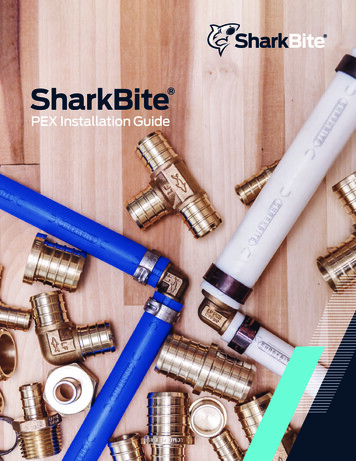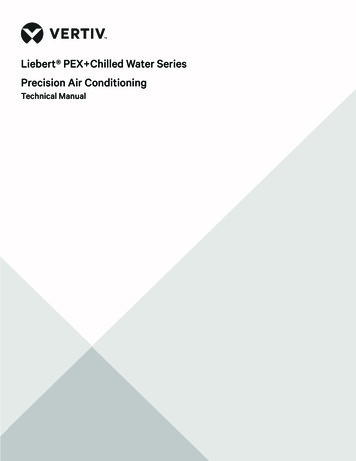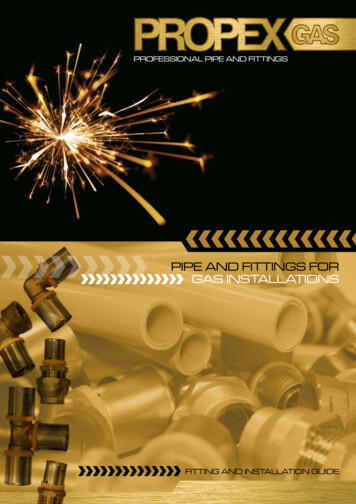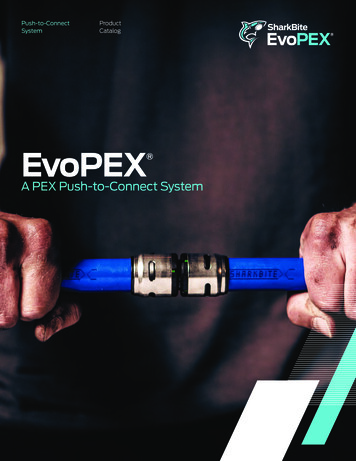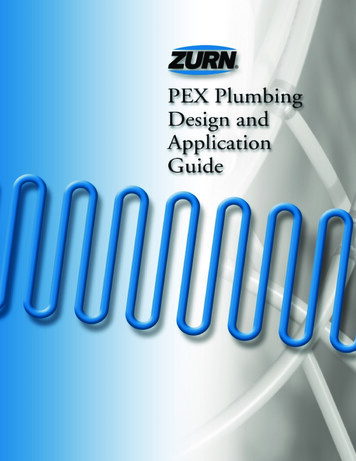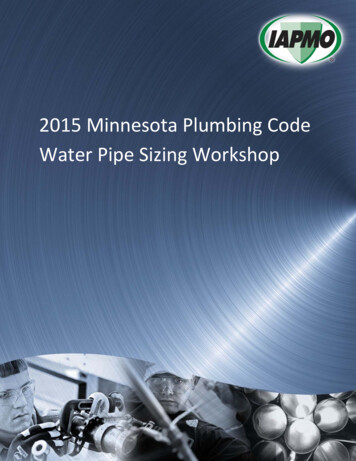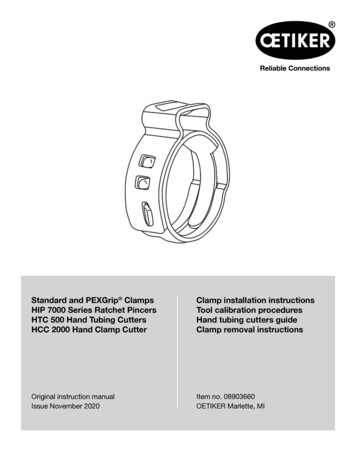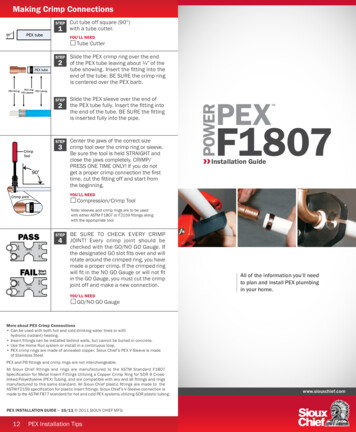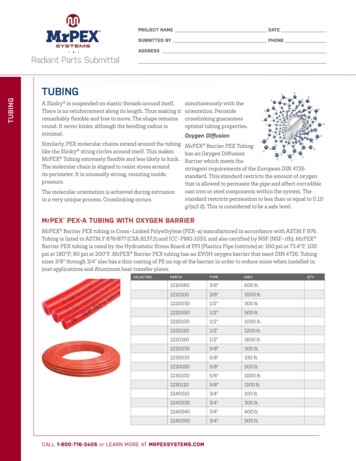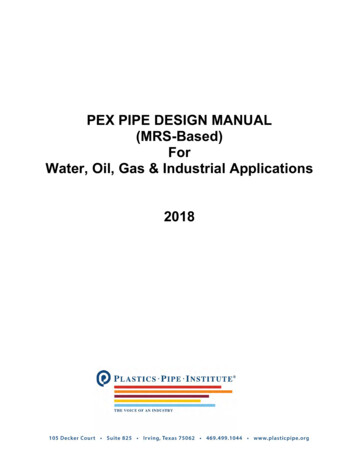
Transcription
PEX PIPE DESIGN MANUAL(MRS-Based)ForWater, Oil, Gas & Industrial Applications2018
ForewordThis Manual was developed and published with the technical help and financial support of themembers of the PPI (Plastic Pipe Institute). The members have shown their interest in qualityproducts by assisting independent standards-making and user organizations in the development ofstandards, and also by developing reports on an industry-wide basis to help engineers, codeofficials, and users.This Manual has been prepared by PPI as a service to the industry. The information in this Manualis offered in good faith and believed to be accurate at the time of its preparation, but is offered “asis” without any express or implied warranty, including WARRANTIES OF MERCHANTABILITYAND FITNESS FOR A PARTICULAR PURPOSE. Any reference to testing of a particularproprietary product should not be construed as an endorsement by PPI who does not endorse theproprietary products or processes of any manufacturer. The information in this Manual is offeredfor consideration by industry members in fulfilling their own compliance responsibilities. PPIassumes no responsibility for compliance with applicable laws and regulations.PPI intends to revise this Manual from time to time, in response to comments and suggestionsfrom users of this document. Please send suggestions for improvements to PPI. Information onother publications can be obtained by contacting PPI directly or visiting the web site.The Plastics Pipe Institute, Inc.469-499-1044http://www.plasticpipe.orgThis manual was first issued in December 2018. 2018 The Plastics Pipe Institute, Inc.ii
PEX PIPE DESIGN MANUAL (MRS-BASED)FOR WATER, OIL, GAS & INDUSTRIAL APPLICATIONSTable of ContentsList of Figures . vList of Tables . viPEX PIPE DESIGN MANUAL (MRS-BASED) . 1FOR WATER, OIL, GAS & INDUSTRIAL APPLICATIONS . 11.0INTRODUCTION . 12.0SCOPE . 13.0PEX SYSTEM SOLUTIONS . 23.1. PEX Solutions for Hot and Cold Water . 23.2. PEX Solutions for Infrastructure Applications . 43.3. PEX Solutions for Industrial Applications. 64.0PRESSURE RATINGS FOR PEX PIPES . 74.1. ASTM Pressure Rating Method . 74.2. ISO Pressure Rating Method . 85.0PEX PIPES: DIMENSIONS . 116.0PEX PIPES: PROPERTIES . 126.1. General PEX Pipe Properties . 126.2. PEX Engineering Properties . 126.3. PEX Head Loss Data Charts For Full Flow Conditions. 177.0PEX PIPES: DESIGN CONSIDERATIONS . 177.1. Water Design Considerations . 177.2. Slurry Design Considerations . 207.3. Surge Pressure (Water Hammer) . 227.4. Vacuum/Suction Pipelines . 277.5. Non-Restrained Fittings and Pullout Prevention Techniques . 307.6. Inclined Pipes, Dewatering and High-Gradient Supply Lines . 347.7. Instructions for Underground Installation of PEX Piping System . 447.8. Above-Ground Installation Guidelines . 46iii
8.0PEX FITTINGS . 578.1. PE100 Electrofusion fittings . 578.2. PEX-Lined Fittings . 598.3. Flared End Connectors . 608.4. Brass Fittings for PEX Pipes . 618.5. Design Considerations for PEX Fittings. 619.0PRESSURE TESTS. 639.1. Performing Pressure Tests in PEX Water Supply Lines and Dewatering . 6310.0PEX CHEMICAL RESISTANCE . 64APPENDIX A - Tables of Dimensions . 65A.1IPS PIPE SIZES. 65A.2METRIC PIPE SIZES. 71APPENDIX B - Flow Rate Tables . 76iv
LIST OF FIGURESFigure 1.Figure 2.Figure 3.Figure 4.Figure 5.Figure 6.Figure 7.Figure 8.Figure 9.Figure 11.Figure 12.Figure 13.Figure 14.Figure 15.Figure 16.Figure 17.Figure B.1.Figure B.2.Figure B.3.Figure B.4.Figure B.5.Figure B.6.Figure B.7.Figure B.8.Figure B.9.Figure B.10.Figure B.11.Figure B.12.Figure B.13.Figure B.14.Infrastructure-hot water installation example . 2Riser system installation example . 3PEX Infrastructure Application . 4Pumping water from Borehole . 6Industrial installation example showing a variety of fittings. 7Pre-Insulated PEX Pipe . 29Fixpoint Clamp . 31Floating Fixpoint Device . 32Pullout Prevention Device . 33Floating Fixpoint Device with Flanges . 33Flared End Connector . 34Fixpoint Bridge . 34Fixpoint Bridge Diagram . 34Using a Fixpoint Bridge in a Dewatering line . 44Maximum Support Distance - IPS sizes . 48Maximum Support Distance - Metric sizes . 49IPS Sizes - DR 21. 77IPS Sizes - DR 17. 78IPS Sizes - DR 13.5. 79IPS Sizes - DR 11. 80IPS Sizes - DR 9. 81IPS Sizes - DR 8.3. 82IPS Sizes - DR 7.3. 83Metric Sizes - DR 26. 84Metric Sizes - DR 16.2. 85Metric Sizes - DR 13.6. 86Metric Sizes - DR 11. 87Metric Sizes - DR 9. 88Metric Sizes - DR 7.4. 89Metric Sizes - DR 6. 90v
LIST OF TABLESTable 1.Table 2.Table 3.Table 4.Table 5.Table 6.Table 7.Table 8.Table 9.Table 10.Table 11.Table 12.Table 13.Table 14.Table 15.Table 16.Table 17.Table 18.Table 19.Table 20.Table 21.Table A.1.Table A.2.Table A.3.Table A.4.Table A.5.Table A.6.Table A.7.Table A.8.Table A.9.Table A.10.Table A.11.Table A.12.Table A.13.Table A.14.Table A.15.Table A.16.Table A.17.Table A.18.Table A.19.Maximum operating pressures [psig] for conveying water in PEX 100pipes, with a design coefficient C 1.25 and temperature in F . 11Maximum operating pressures [bar] for conveying water in PEX 100pipes, with a design coefficient C 1.25, and temperature in C. 11Elastic Modulus (psi) vs. Temperature T (oF). 14Elastic Modulus (MPa) vs. Temperature ( C) . 14Reduction factors as a Function of Temperature . 17Replacing Carbon Steel Slurry Pipes with PEX Pipes (IPS) . 21Replacing Carbon steel slurry pipes with PEX pipes (Metric) . 21Correction Factors for Abrasion . 22Surge Pressures in PEX Pipes (Line Velocity 3 ft/sec.) . 25Surge Pressures in PEX pipes. 26Towing of empty PEX pipe – maximum allowable length for all DRs . 43Trench width . 45Coefficients . 47Correction factors . 50Initial Short-term thermal stresses . 52Sum of Values of Thermal Stresses from Table 15 . 53Sum of Values of Thermal Stresses from Table 15 . 54Working Pressures (psig). 59Working Pressures (bar) . 59Pressure test - psig . 64Pressure test - bar . 64Comparison of Class, Pipe Series and Dimension Ratio . 65PEX IPS Pipe Properties – DR 26 . 66PEX IPS PIPE PROPERTIES – SDR 21 . 66PEX IPS PIPE PROPERTIES – SDR 17 . 67PEX IPS PIPE PROPERTIES – DR 15.5 . 67PEX IPS PIPE PROPERTIES – SDR 13.5 . 68PEX IPS PIPE PROPERTIES – SDR 11 . 68PEX IPS PIPE PROPERTIES – SDR 9 . 69PEX IPS PIPE PROPERTIES – DR 8.3 . 69PEX IPS PIP PROPERTIES – DR 7.3 . 70PEX IPS PIPE PROPERTIES – DR 6 . 70PEX PIPE Properties – SDR 26 (Series 12.5) . 71PEX PIPE Properties – SDR 21 (Series 10) . 72PEX PIPE Properties – DR 16.2 (Series 7.6). 72PEX PIPE Properties – DR 13.6 (Series 6.3). 73PEX PIPE Properties – SDR 11 (Series 5) . 73PEX PIPE Properties – SDR 9 (Series 4) . 74PEX PIPE Properties – DR 7.4 (Series 3.2). 74PEX PIPE Properties – DR 6 Series 2.5) . 75vi
PEX PIPE DESIGN MANUAL (MRS-BASED)FOR WATER, OIL, GAS & INDUSTRIAL APPLICATIONS1.0INTRODUCTIONPolyethylene (PE) has been the material of choice for pressure piping applications such aswater and oil/gas for over 40 years, both in North America and internationally. PE materialscan be crosslinked to achieve even higher performance properties as crosslinkedpolyethylene (PEX). Crosslinking the PE molecules in a three-dimensional network results ina broader operating temperature range. These enhanced properties make PEX pipe morecost competitive with steel pipe, while maintaining all the benefits of plastic piping for water,industrial, mining, underground fire extinguishing lines, and oil and gas applications. PEXpipe has an excellent global reputation based on accredited international standards in morethan 40 countries, along with decades of proven track record with established end usersaround the world.2.0SCOPEThis “PEX PIPE DESIGN MANUAL For Water, Oil, Gas, and Industrial Applications”describes PEX pipes that are used in a wide range of operating temperatures from -58 F to200 F (-50 C to 93 C), in a variety of nominal pipe sizes (NPS) and dimension ratios (DR’s)ranging from NPS 3 to NPS 54 for inch pipe sizes and DN 75 to DN 1000 for metric pipesizes, and pipes that are joined by the electrofusion process or mechanical fittings. Largediameter PEX pipe systems provide cost-effective, long-term solutions for variousinfrastructures, such as water, oil, gas, fire protection, industrial, and mining sectorsthroughout the world. For gas distribution applications, US Department of TransportationPipeline and Hazardous Materials Safety Administration (PHMSA) requires a special permit,and Canadian regulators require a variance.This PEX PIPE DESIGN MANUAL (MRS-Based) reviews the pressure rating of PEX pipesobtained from the International Standards Organization (ISO) method called the MRS(minimum required strength) using ISO 9080 and ISO 12162. A similar PEX PIPE DESIGNMANUAL (HDB-Based) reviews the pressure rating of PEX pipes obtained with the ASTMmethod called the HDB (hydrostatic design basis) based on ASTM D2837. The pressurerating criteria of the two pressure rating methods should not be interchanged. TheseManuals also discuss key PEX physical properties, such as its resistance to slow crackgrowth (SCG) and rapid crack propagation (RCP). Pressure rating, SCG and RCP are threevery important attributes for a plastic pipe used in large-diameter pressure pipe applications.Smaller diameter PEX tubing, such as those covered in ASTM F876 (NTS 1/8 to 6), isdiscussed in the “PPI DESIGN GUIDE for Residential PEX Water Supply PlumbingSystems” and numerous other PPI documents. In general, PEX tubing is commerciallyavailable in sizes up to and including NTS 4 and PEX pipe is available in large diametersNPS 3 and above. This document does not attempt to address the typical applications ofcopper tube size (CTS) PEX tubing as per ASTM F876 such as potable water, water servicelines, residential fire protection, hydronic radiant heating and cooling, and geothermalground loop piping.1
For PEX materials, “tubing” refers to products whereby the actual outside diameter (OD) is1/8 inch larger than the nominal size, which is the same as that for copper water tube, thuscommonly referred to copper tube size (CTS). Product standards ASTM F876 and CSAB137.5 apply to PEX tubing. “Pipe” refers to products whereby the actual OD matches thatof steel or iron pipe of the same nominal size, commonly referred to as iron pipe size (IPS).ASTM F2788, F2905, and F2968 and CSA B137.19 apply to PEX pipe. The terms “pipe”and “piping”, as well as “tube” and “tubing”, are used interchangeably in this document.3.0PEX SYSTEM SOLUTIONS3.1.PEX Solutions for Hot and Cold WaterPEX pipe manufacturers supply both un-insulated and pre-insulated pipesystems for district heating: transporting hot and cold water from central systemsto buildings – See Figure 1. In flowing conditions, pre-insulated pipes maintainthe heat even under extremely cold ground conditions and transport hot and coldwater in long, continuous pipelines.Figure 1. Infrastructure-hot water installation example2
3.1.1.Hot-Water RisersPEX pipes may be used for closed-loop and open-loop risers – seeFigure 2. The pipes can be supplied in coils with all the required brassfittings including branch-off saddles, reducing tees, and more.Figure 2. Riser system installation example3
3.2.PEX Solutions for Infrastructure ApplicationsComplete cold-water supply systems and industrial pipelines can be created bycombining PEX pipes and PE (up to 140 F) or PEX (up to 200 F) electrofusionfittings – see Figure 3. Installation guidelines and electrofusion joininginstructions are available from the pipe and fitting manufacturers.Figure 3. PEX Infrastructure Application4
3.2.1.PEX fire extinguishing linesPEX pipes offer complete solutions with electrofusion fittings and outletsfor use in fire protection lines, such as underground water supply for fireextinguishing lines. PEX pipes and fittings should be third-party listedand/or approved (e.g. by UL or FM) for fire protection systems.3.2.2.PEX lines for very low ambient temperaturesSpecially designed pre-insulated PEX pipes can be installed aboveground in very low ambient temperatures to maintain the fluid’stemperature in flowing conditions over relatively long distances. PEXpipes are suitable for industrial and infrastructure applications foroperating temperatures as low as -58 F (-50 C).3.2.3.Oil and Gas/Natural gas pipesPEX pipelines designed for gas gathering or oil/gas applications shallmeet the requirements of ASTM F2968, ASTM F2905, or ISO 14531.The main advantages of PEX pipes for these applications Maximum service temperature of 200 F (93 C). Note –applications above 200 F (93 C) require special designconsideration.Minimum service temperature of -58 F (-50 C).No sand bedding is needed due to SCG resistance – see ISO14531-4.PEX pipes may be joined by PE or PEX electrofusion fittings,based on temperature requirements.RCP arrest temperature as low as -58 F (-50 C).Dewatering LinesPEX pipes are a good solution for dewatering lines in miningapplications. They can be supplied in various pressure ratings in longcontinuous lengths and can be dragged on the ground to the finallocation. PEX pipes are easily installed, as they do not requireanchoring. The end fittings should be protected by a pullout preventiontechnique such as fixpoints. Fittings along the line should be protectedby a floating fixpoint device.5
3.2.5.Riser Mains for Wells/BoreholesPEX pipes may be used for pumping water from water boreholes – seeFigure 4. The pipes are generally supplied with special borehole fittings.Figure 4. Pumping water from Borehole3.3.PEX Solutions for Industrial ApplicationsPEX pipes, with excellent resistance to temperature extremes, chemicals andabrasion, have been shown to be excellent candidates for a wide range ofindustrial applications. Examples include transporting slurries, gypsum, sand,salt, phosphates, silts, potash, various chemicals, and industrial wastes. SeeFigure 5 for an example of an industrial application. PEX pipes offer successful,cost-effective solutions where other pipes would be unsatisfactory for conveyingslurries, either due to their lower abrasion resistance or because of vulnerabilityto chemicals.6
Figure 5. Industrial installation example showing a variety of fittings4.0PRESSURE RATINGS FOR PEX PIPESThe pressure rating of PEX pipes covered by this document is obtained by the minimumrequired strength (MRS) method as defined by ISO 9080 and ISO 12162.4.1.ASTM Pressure Rating Method4.1.1.The ASTM HDB pressure rating method is discussed in PPI “PEX PIPEDESIGN MANUAL (HDB-Based) For Water, Oil, Gas & IndustrialApplications”.7
4.2.ISO Pressure Rating Method4.2.1.MRS (Minimum Required Strength)The ISO pressure rating method utilizes pipe samples tested at threedifferent temperatures with the linear log stress – log time 68 F (20 C)regression line extrapolated to 480,000 hours (50 years). The lowerconfidence level (LCL) of the extrapolated value is called the lowerpredictive level (LPL) and the categorized value of the LPL is called theminimum required strength (MRS) in accordance with ISO 9080 and ISO12162. The MRS is only obtained at 20 C and 50 years. These MRSvalues are also published in PPI TR-4, which is available on the PPIwebsite - www.plasticpipe.org.The PPI listings of MRS values are also classified in accordance with thematerial's standard pipe material designation code. In this ISOdesignation system, the plastic pipe material is identified by its standardabbreviated terminology followed by two or three digits, which are theMRS value multiplied by 10. An example of this ISO pipe materialdesignation code is as follows:4.2.1.1.PEX 100 (PE-X 100) is a crosslinked polyethylene (the PE-Xabbreviation is in accordance with ISO) with an MRS of 10MPa.The design engineer uses the MRS pressure rating formula(see Equation 1) below to calculate the maximum operatingpressure (MOP) for his PEX pipe:MOP 20 (MRS) / [(DR – 1) (C)]Where:(Eq. 1)MOP maximum operating pressure, barMRS minimum required strength, MPa, at 20 C and 50 yearsC (design coefficient) 1.25 for water or gas gathering pipeDR dimension ratioAn example calculation for a DR 11, PEX 100 pipe with an MRS of 10 MPa is:P 20 (10) / [(11-1) (1.25)] 16 bar 232 psig.This is the maximum operating pressure or pressure rating for DR 11 PEX 100 pipe usingthe ISO recommended minimum design coefficient (C) of 1.25. The design engineer mayuse a higher design coefficient if deemed appropriate for the installation.8
An example calculation for a DR 7 PEX 100 pipe with an MRS of 10 MPa is:P 20 (10) / [(7-1) (1.25)] 26.6 bar 385 psig.4.2.2.CRS (Categorized Required Strength)Another useful feature of the ISO pressure rating system is the CRS(categorized required strength) rating. For classification purposes, theMRS is always defined as the LPL at 20 C and 50 years. A PEX 100material will always be classified as a PEX 100 material independent ofthe actual use conditions.However, for design purposes, the ISO system provides the designengineer with the opportunity to design his piping system at the actualuse temperature and also for the desired design time. To do this, thedesign engineer simply uses the categorized required strength (CRS)instead of the MRS in the pressure rating equation – Equation 1. TheseCRS values are also categorized values of the LPL. The difference isthat the LPL is the extrapolated value at the desired use temperatureand the desired design time.ISO 9080 and ISO 12162 provide guidelines and restrictions forcalculation of these LPL values for the CRS. For extrapolations beyond50 years, (e.g. 100 years), ISO 9080 requires longer-term data to justifythe extrapolation.The CRS method accounts for the higher strength of the plastic pipe atdesign temperatures lower than 20 C, and the lower strength of theplastic pipe at higher design temperatures. These CRS values are veryeasy to obtain because the PEX pipe manufacturer already has thestress rupture data at three temperatures per ISO 9080, and simply usesthe same 3- or 4-coefficent Rate Process Method equation of ISO 9080to determine the LPL at the desired design temperature and desiredtime. Thus, the design engineer uses the same pressure ratingEquation 1 to calculate the MOP for the PEX pipe, except that the CRSis used instead of the MRS:MOP 20 (CRS) / [(DR – 1) (C)]Where:(Eq.1)CRS categorized required strength, MPa, at the selected temperature andat the selected time.An example calculation for a DR 11 PEX 100 pipe with a CRS of 12.5 MPa at 32 F (0 C)and 50 years is:P 20 (12.5) / [(11-1) (1.25)] 20 bar 290 psig.9
An example calculation for a DR 7 PEX 100 pipe with a CRS of 12.5 MPa at32 F (0 F C) and 50 years is:P 20 (12.5) / [(7-1) (1.25)] 33.3 bar 483 psig.4.2.3.Maximum Operating Pressure (MOP) Based ISO 9080 ReferenceCurvesA frequently used approach for determining the MOP is to use referencecurves based on ISO 9080 regression lines. ISO reference curves forPEX are based on an average value of the 97.5% LCL regression linesobtained for a number of PEX pipe materials. These ISO referencecurves need to be verified by the CRS method if the temperatures gooutside the limits of ISO 9080 testing or the product standard. TheseISO reference curves are generic because they are based on severalPEX materials; therefore, the resulting value will be quite conservative.The CRS method will generally result in a higher MOP value than theReference Curve method because it is based on the actual values forthe specific PEX material.Tables 1 and 2 are a summary of the maximum operating pressure(MOP) for a PEX 100 pipe at various temperatures for various dimensionratios (DR) based on these ISO reference curves. The effect oftemperature in this case is based on ISO reference curves. Table 1MOP values are in psig and temperatures are in degrees Fahrenheit.Table 2 MOP values are in bar and temperatures are in degrees Celsius.Both Table 1 and Table 2 also include the Pipe Series (S), a pipe sizingsystem similar to the dimension ratio (DR) that is used internationally.These tables represent basic PEX 100 performance data according tostandard ISO reference curves. The PEX pipe producer can either usethese generic ISO reference curves or present their own additional datafor their specific PEX pipe to support the use of the CRS method.10
Table 1. Maximum operating pressures [psig] for conveying water in PEX 100 pipes, with adesign coefficient C 1.25 and temperature in FTemperature( F)507090100120140160180190200Years 070.061.054.050.047.0Pipe series (S)7.66.354Dimension ratio (DR)16.213.6119Maximum Operating Pressure 0192.0Table 2. Maximum operating pressures [bar] for conveying water in PEX 100 pipes, with adesign coefficient C 1.25, and temperature in CTemperature( C)5.0Years ofservicePipe series (S)12.51026217.66.354Dimension ratio (DR)16.213.6119Maximum operating pressure 55.06.96.58.88.211.010.513.813.2PEX PIPES: DIMENSIONSPipe dimension tables are in Appendix A for metric and inch-based pipe sizes.11
6.0PEX PIPES: PROPERTIES6.1.General PEX Pipe PropertiesCrosslinked polyethylene (PEX) is a polyethylene material that has undergone achange in molecular structure through processing whereby a majority ( 65%) ofthe polymer chains are chemically linked.The crosslinked structure of the PEX pipe renders excellent properties such as:o Temperature operating range -58 F to 200 F (-50 C to 93 C)Note: applications above 200 F (93 C) require special design consideration.o Corrosion resistanceo Toughnesso Chemical resistanceo Very low friction coefficient: Hazen-Williams C 150 to 155o Abrasion resistanceo Longevityo Resistance to slow crack growth (SCG)o Low creepo Resistance to rapid crack propagation (RCP)These properties provide important advantages compared to standard HDPEpipes, as discussed in PPI TN-17.6.2.PEX Engineering Properties6.2.1.PEX Slow Crack Growth (SCG) ResistanceSlow crack growth (SCG) is a failure mechanism that can occur in thefield with certain materials in certain circumstances. SCG resistance is akey material property of plastic piping materials because it is a fa
PEX PIPE Properties - DR 6 Series 2.5). 75. 1 . PEX PIPE DESIGN MANUAL (MRS-BASED) FOR WATER, OIL, GAS & INDUSTRIAL APPLICATIONS . 1.0 INTRODUCTION . Polyethylene (PE) has been the material of choice for pressure piping applications such as water and oil/gas for over 40 years, both in North America and internationally. .
